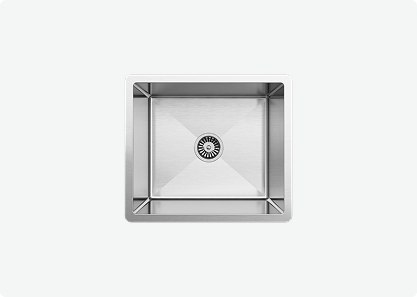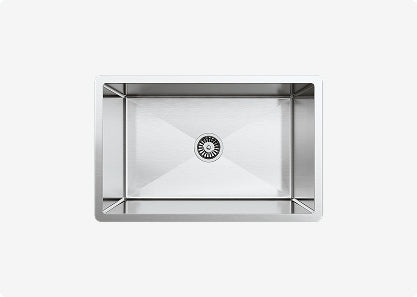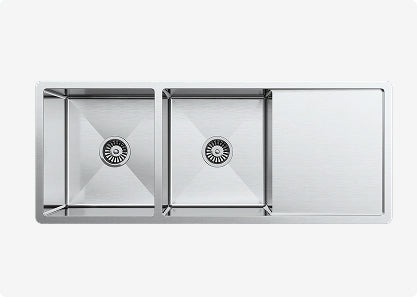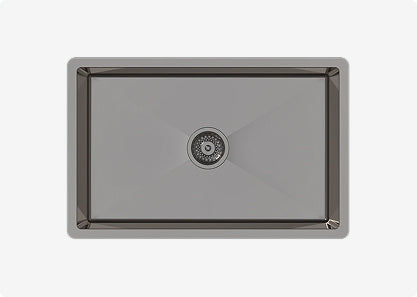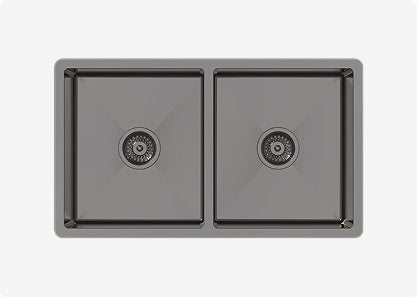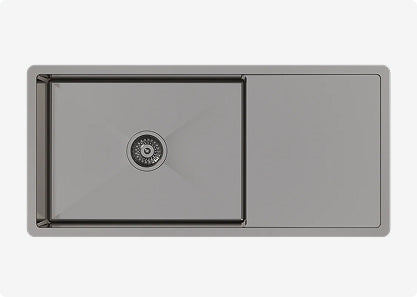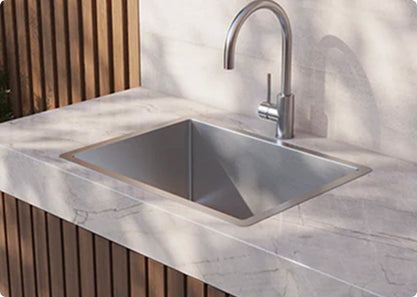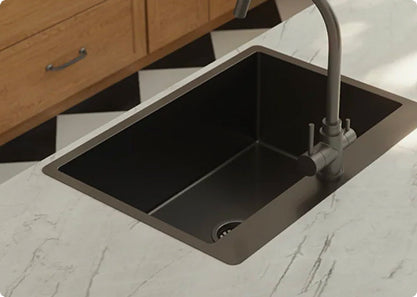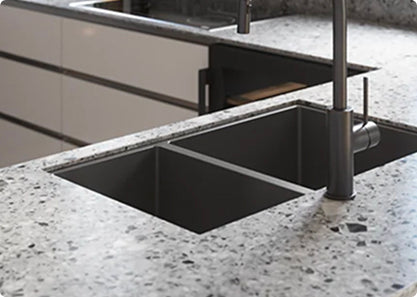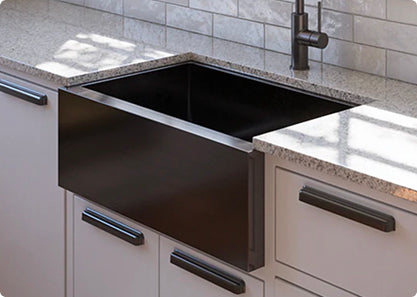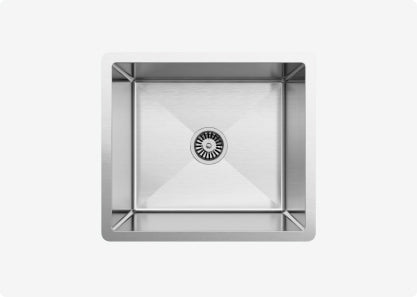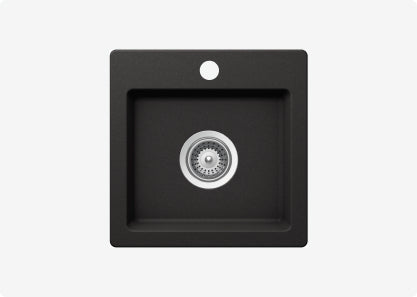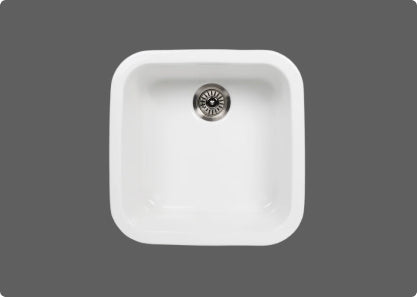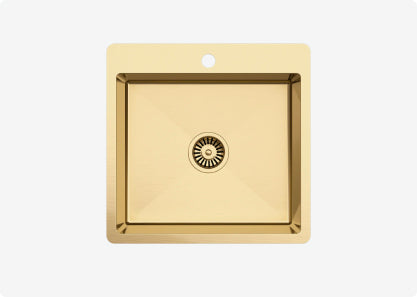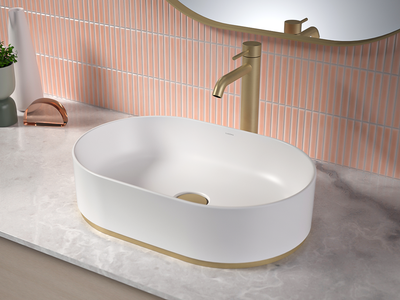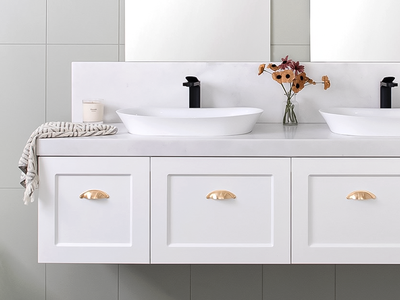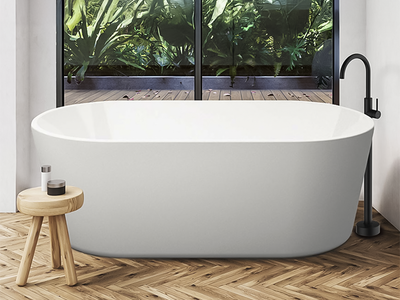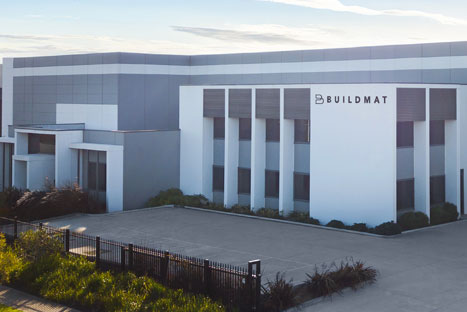The Renovator’s Guide to the Best Kitchen Sinks (2025)
A well-chosen sink sets the tone for your kitchen renovation.
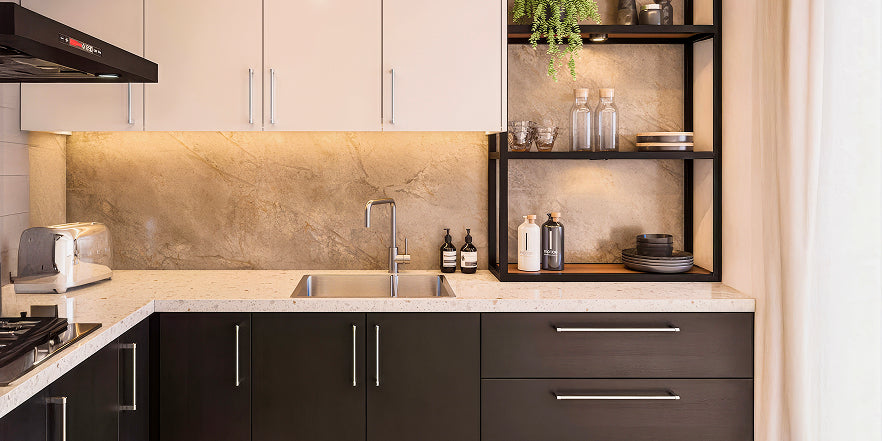
This guide delivers practical insights, detailed comparisons, and clear recommendations to help you select a sink that meets your functional and aesthetic needs. Discover the features of various sink types and make the best decision for your project.
How Much Should You Budget for a Kitchen Sink?
Budget around 5% of your total kitchen renovation cost for the kitchen sink and tapware. This ensures you allow enough for form and function, without underestimating how much your sink shapes daily use.
Sinks might seem minor, but they’re one of the most-used fixtures in the kitchen. While it’s tempting to splurge on design or cut corners to save, your budget should reflect real-world usage. Start by anchoring your spend to your overall kitchen budget, then adjust based on materials, size, and mounting complexity. A little flexibility goes a long way if you're eyeing premium finishes or statement fixtures.
💎 Buildmat Kitchen Sink Budgeting Tip
Kitchen budgets can blow out quickly, especially with benchtops and appliances. Plan your sink early so it fits both your layout and cabinetry, not just your wishlist. If you're unsure, chat with our team before cut-outs are locked in.
Further Reading
Choose Your Size and Configuration
What Size Sink Works Best for Your Kitchen Layout?
Choose a sink size that fits your base cabinet and matches how you use the space. Big sinks suit busy kitchens, while small ones save space. Measure before you shop, and try not to fall in love with something that won’t fit.
Before jumping to style or finish, check your measurements. Your sink should suit the scale of your kitchen and the way you like to cook and clean. Measure the internal width, depth, and height of your base cabinet and your countertop cut-out before committing. This ensures the sink fits, avoids cut-out mistakes, and streamlines your shortlist.
Small Sinks
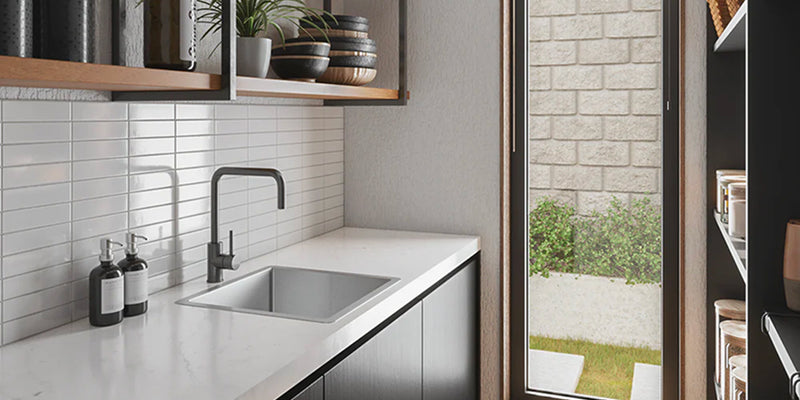
WHY A SMALL SINK IS PERFECT FOR COMPACT KITCHENS
Small kitchen sinks are space-savers, great for apartments, galley layouts, or secondary prep stations. They clean up quickly, use less water, and leave more bench space for food prep.
When paired with custom-fit accessories like roll-out drainers or colanders, even small sinks can handle surprisingly big jobs.
WHAT TO CONSIDER BEFORE CHOOSING A SMALL SINK
Small bowls limit multitasking and struggle with large items like baking trays or woks. This may slow down routines if there’s no dishwasher to help out. Choose deeper models to increase vertical space, and consider pairing with a portable drainboard or over-sink prep set.
Large Sinks & Sink Troughs
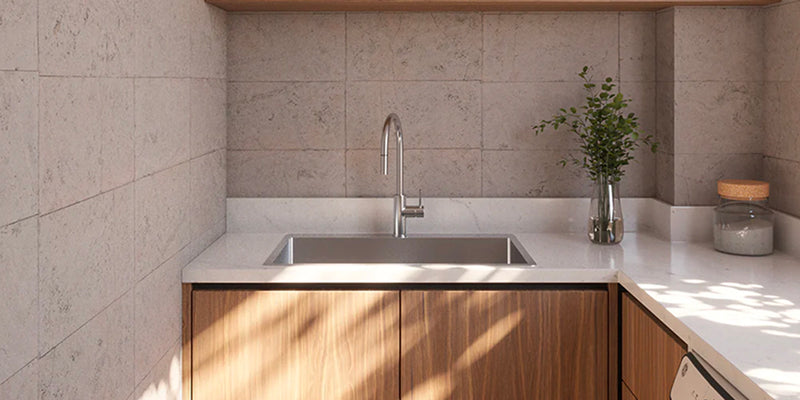
WHY LARGER SINKS ARE GREAT FOR SERIOUS COOKS
Wide sinks give you room to handle large pots, wash bulk ingredients, or soak multiple dishes at once. They’re great for entertainers, big families, or home chefs who value room to move.
Paired with prep boards and drying racks, a wide sink can double as a central workstation.
WHAT TO CONSIDER BEFORE CHOOSING A LARGER SINK
Large kitchen sinks and troughs need more bench space, deeper cabinets, and sometimes structural reinforcement. Larger bowls also hold more water, which means higher usage and heavier weight.
Always confirm cabinet width, bench thickness, and drainage layout before choosing an oversized sink model.
Further Reading
Which Sink Configuration Best Matches Your Kitchen Workflow?
Choose a sink layout that reflects how you actually cook, clean, and move through your kitchen, because the wrong configuration can slow you down, while the right one makes every task smoother.
That’s why it pays to look beyond size and start thinking about how the layout works with your routine.
Choose a fit that balances your cooking habits, cleaning style, and available space. Think about how you rinse produce or soak pans, how many people use the space and where your dishes dry. The option you choose should adapt to fit your work style.
Single Bowl
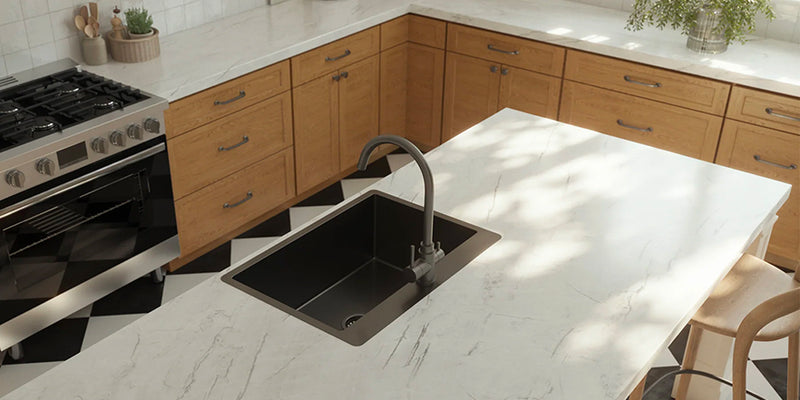
WHY A SINGLE-BOWL SINK OFFERS SIMPLICITY AND SPACE
Single-bowl kitchen sinks provide a wide, uninterrupted workspace that’s perfect for soaking large trays or washing deep pots. Their clean, open design suits minimalist kitchens and households that prioritise ease of use.
They’re also easy to clean—fewer seams, no dividers, and fewer places for grime to build up. With accessories like over-sink racks, chopping boards, or colanders, single bowls can function as full prep zones.
WHAT TO CONSIDER WHEN CHOOSING A SINGLE-BOWL SINK
With one large bowl, tasks can’t be separated, so soaking dishes while prepping produce gets tricky. This layout works best for homes with dishwashers or those who value open space over multi-tasking.
You’ll need to consider your sink's depth: too shallow and you’ll get splashback; too deep and it may strain your posture. If separation is important, look into workstation kits or clip-in accessories.
Double Bowl
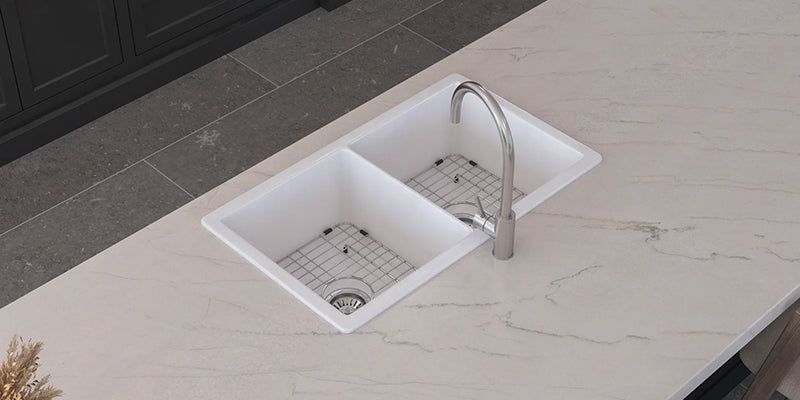
WHY A DOUBLE BOWL SINK SUPPORTS MULTI-TASKING
Double-bowl kitchen sinks split your sink into two, letting you rinse in one and soak in the other. This is ideal for busy households or meal-prep lovers who often juggle clean and dirty tasks at once.
They’re also helpful when multiple people share the kitchen—no waiting for a free bowl. Some styles even mix one full-size and one compact bowl to balance space with flexibility.
WHAT TO CONSIDER BEFORE CHOOSING A DOUBLE BOWL SINK
The centre divider can restrict space for large pots or trays. If you cook with oversized cookware, opt for an asymmetrical bowl layout or at least one oversized bowl.
Ensure your benchtop and cabinetry can support a wider sink and dual-drain setup. Installation can be more complex with the extra plumbing required.
Drainboard Sinks
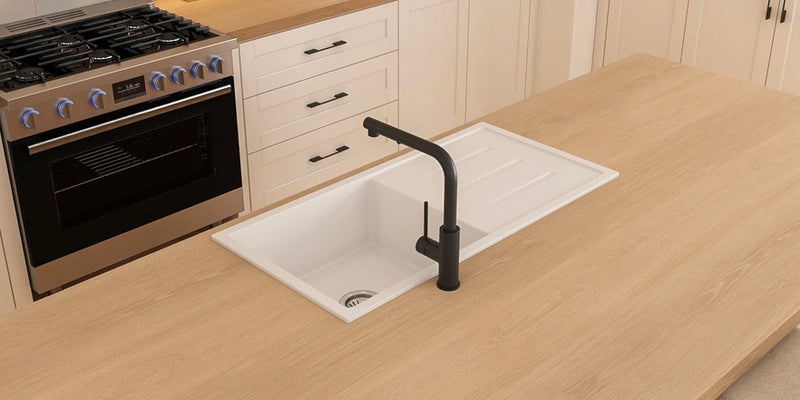
STREAMLINE DAILY TASKS WITH A DRAINBOARD SINK
Drainboards give you a built-in drying or staging area without needing extra bench space. Great for homes with limited space or without dishwashers, they keep your counters dry and clutter-free.
Many drainboards also double as prep zones, giving you extra flexibility in tight layouts. You can rinse produce, dry pans, or stack dishes—all while water drains neatly back into the sink.
WHAT TO CONSIDER BEFORE CHOOSING A DRAINBOARD SINK
Drainboard kitchen sinks take up more horizontal space, so check that your kitchen layout can handle the extra width. Most models are handed (left or right side) so match this to your kitchen workflow.
Avoid models with flat or shallow drainboards that let water pool. Look for deep grooves and good slope.
How Installation Style Affects Kitchen Workflow and Maintenance
Installation style affects how easy your sink is to clean, how smoothly your benchtop flows, and what materials you can use. Choose a style that complements your kitchen’s layout and suits your routine.
Some installations, like undermount and flushmount, make wiping mess into the sink seamless but require stone surfaces and professional installation. Top-mounts are easier to DIY and replace, but the rim can trap grime. Farmhouse styles are ergonomic and striking but need tailored cabinetry. The style you pick changes your kitchen’s look and shapes your daily use.
💎 Buildmat Pro Installation Tip
Want easier cleaning? Look for rimless styles like undermount or flushmount. Prefer flexibility or renting? Top-mount sinks are quick to install and remove without changing your benchtop.
Top-Mount (Drop-In)
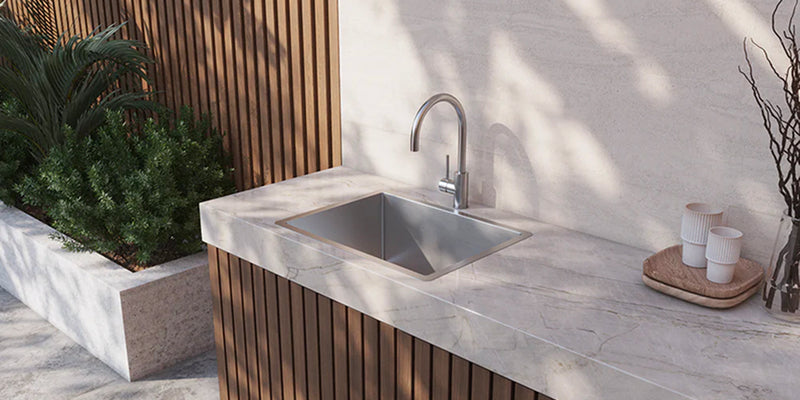
WHY A TOP-MOUNT SINK IS A PRACTICAL CHOICE FOR DIY OR BUDGET BUILDS
Also known as a “drop‑in” or inset, a top-mount sink sits into a cut‑out in the benchtop, with its rim resting on the surface.
This style is popular for its straightforward, DIY‑friendly installation and compatibility with most bench materials. It’s typically more affordable and easier to swap out if you choose to upgrade later. The raised lip also helps contain splashes, especially in busier family kitchens.
WHAT TO CONSIDER BEFORE CHOOSING A TOP-MOUNT SINK
The lip around the edge can collect grime over time and makes it harder to wipe benchtop mess straight into the sink. Visually, top-mounts can feel less streamlined than undermount or flushmount styles, especially in more minimalist or modern designs.
Not all top-mounts are created equal, so choose models with low-profile rims and integrated accessories to maximise function.
Flushmount
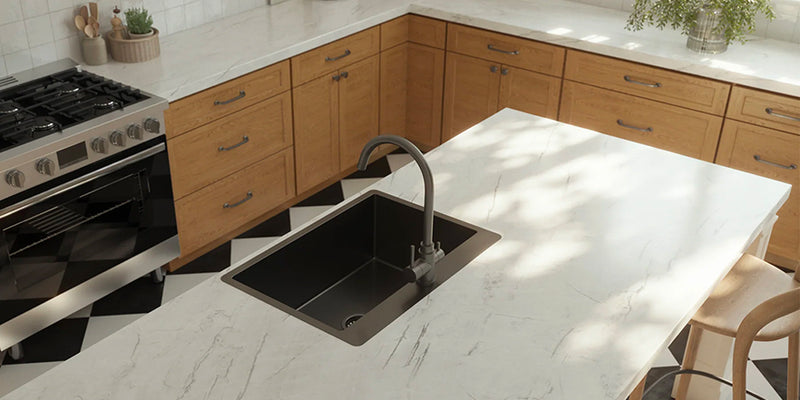
WHY FLUSHMOUNT SINKS OFFER A SEAMLESS, ARCHITECTURAL LOOK
A flushmount kitchen sink is installed level with the benchtop, creating a seamless transition between sink and surface. This creates a clean, architectural look that blends beautifully into stone, porcelain, or composite benchtops.
This style delivers a sleek, contemporary look and lets you sweep water and debris directly into the basin without catching on a rim.
WHAT TO CONSIDER BEFORE CHOOSING A FLUSHMOUNT SINK
Flushmount installation requires extreme precision in sink choice and in benchtop cutting. Any misalignment will be noticeable. It also typically requires a solid surface benchtop like stone or porcelain. Laminate is rarely suitable.
Because it's a more complex install, it may also increase your total reno budget. Always confirm that your builder or stonemason has experience with flushmount installations.
Undermount
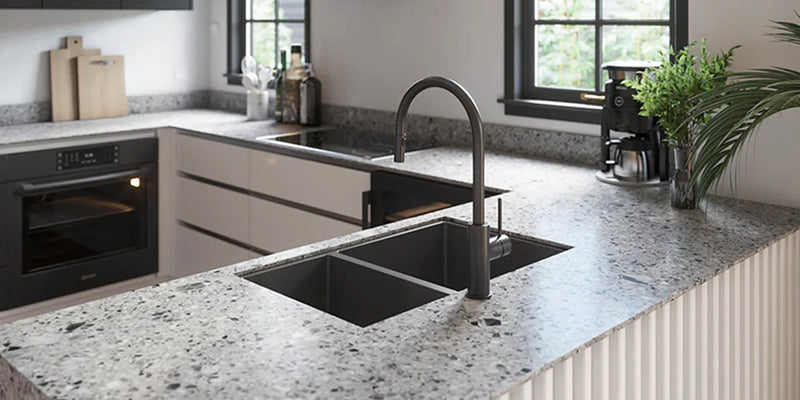
WHEN AN UNDERMOUNT SINK PAYS OFF IN LOOKS AND CLEAN-UP
Undermount kitchen sinks are installed below the benchtop surface, creating a sleek, streamlined look with no visible rim. This makes benchtop clean-up easy, just wipe crumbs or spills directly into the sink with no lip in the way.
It’s a visually clean option that works beautifully with stone and solid surfaces, and it maximises counter space by eliminating edge overhang.
WHAT TO CONSIDER BEFORE CHOOSING AN UNDERMOUNT SINK
Undermount installation requires a solid surface (like engineered stone or concrete) for support (not suitable for laminate or thinner materials). It can also be harder to install or replace, since the sink is fixed beneath the benchtop.
Water can sometimes pool along the join if not sealed correctly, so quality installation is key.
Farmhouse (Butler or Apron-Front)
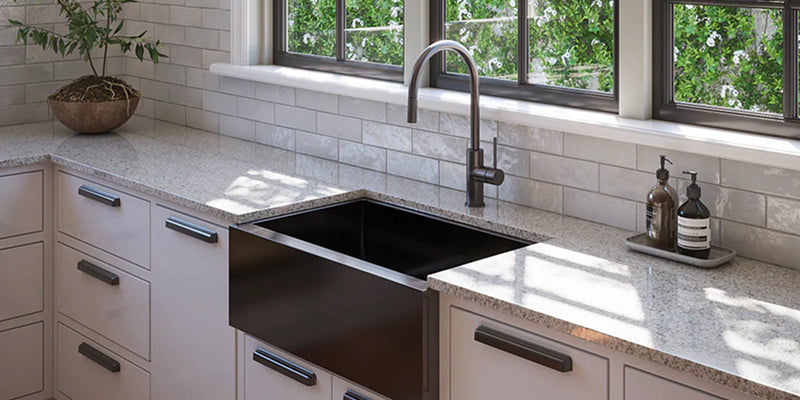
WHY A FARMHOUSE SINK MAKES A STRONG STYLE AND FUNCTIONAL STATEMENT
Farmhouse sinks, also known as butler or apron-front sinks, bring a bold, heritage-inspired look with a deep basin and exposed front panel.
This design makes a bold visual statement and brings the bowl closer to you, reducing the need to lean in and easing back strain when washing large pots. Farmhouse sinks are typically deeper and wider, perfect for heavy‑duty tasks.
They offer a distinctive aesthetic that works well in country, Hamptons, or traditional kitchens, and the forward placement reduces how far you have to reach.
WHAT TO CONSIDER BEFORE CHOOSING A FARMHOUSE SINK
Farmhouse sinks are heavy and require custom cabinetry to support their weight and size. You’ll also need to plan carefully around tapware placement and bench height as they often sit slightly lower than standard sinks.
The exposed front can wear over time, particularly in softer materials like fireclay, and may not suit more modern or streamlined interiors.
How Different Sink Materials Impact Durability, Cleaning and Style
Sink material affects how easily your sink cleans, how well it holds up to heat and impact, and whether it blends in or stands out. Each material has trade-offs: choose based on your kitchen habits and design style.
If you cook daily or have kids, stainless steel or granite composite offer durability and low maintenance. Fireclay works for classic kitchens but can chip if knocked. Copper and brass bring character, but need care to maintain their patina.
Think about what your sink endures day to day, then match the material to the job and your aesthetic.
Stainless Steel
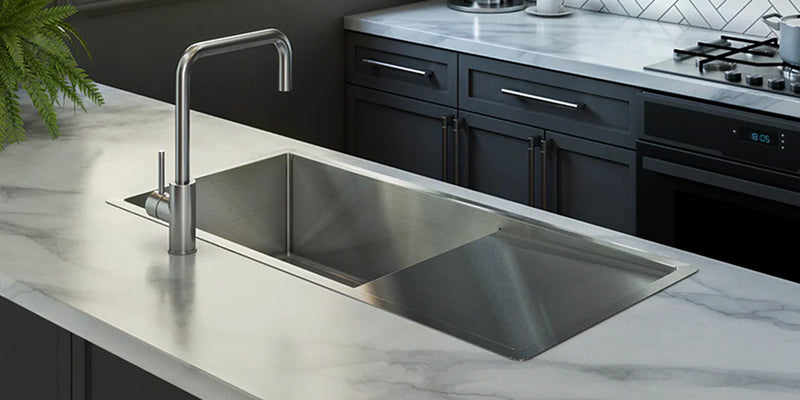
WHY STAINLESS STEEL IS A TOUGH, TIMELESS CHOICE
Stainless steel kitchen sinks are the most popular sink material for a reason. It’s durable, versatile, and easy to maintain. Resistant to heat, stains, and rust, it handles the wear and tear of daily use without fuss. Its neutral metallic finish complements almost any kitchen style, from classic to contemporary.
The material has a bit of give, which helps absorb impact. This reduces the risk of chipping delicate glassware. It's also lightweight and relatively easy to install, making it a go-to choice for both new builds and renovations.
WHAT TO CONSIDER BEFORE CHOOSING A STAINLESS STEEL SINK
Not all stainless steel sinks are created equal: look for a thicker gauge (lower number) to minimise flex, noise, and denting over time. Some cheaper models may feel tinny or sound loud when in use, so opt for sinks with soundproofing pads or undercoating where possible.
While it’s resistant to rust, stainless steel can still scratch and may show water spots more readily than matte or textured finishes. Regular cleaning helps maintain its shine.
Granite Composite
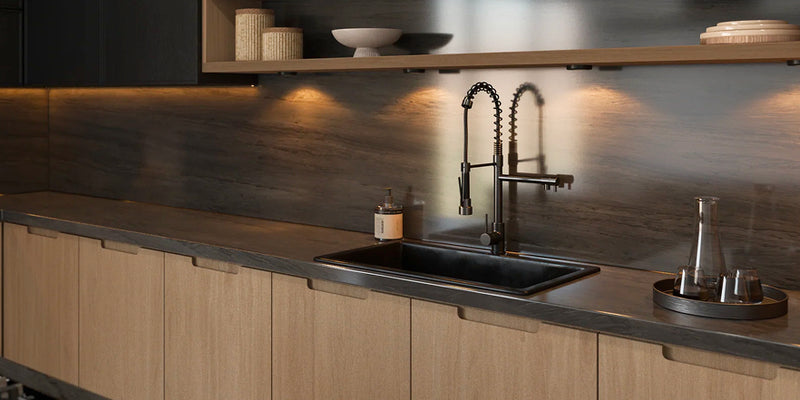
WHY GRANITE SINKS ARE GREAT FOR MODERN, HARDWORKING KITCHENS
Granite composite kitchen sinks are made from a mix of natural stone and resin, creating a dense, ultra-durable surface that resists chips, scratches, and heat. The matte finish gives them a premium, modern look. It’s available in a range of neutral tones that pair effortlessly with stone benchtops or dark cabinetry.
They’re also quieter than metal sinks, thanks to their solid, non-resonant construction, and the speckled or uniform finishes help disguise water marks and fingerprints
WHAT TO CONSIDER BEFORE CHOOSING GRANITE
These sinks are heavier than stainless steel, so proper cabinet reinforcement is often needed. While tough, they’re not totally immune to damage. Dropping a heavy pot can still cause hairline cracks.
Lighter colours can also show marks from food or minerals, so they need regular cleaning. Always check your benchtop’s heat tolerance, as some composites retain heat longer than others.
Fireclay
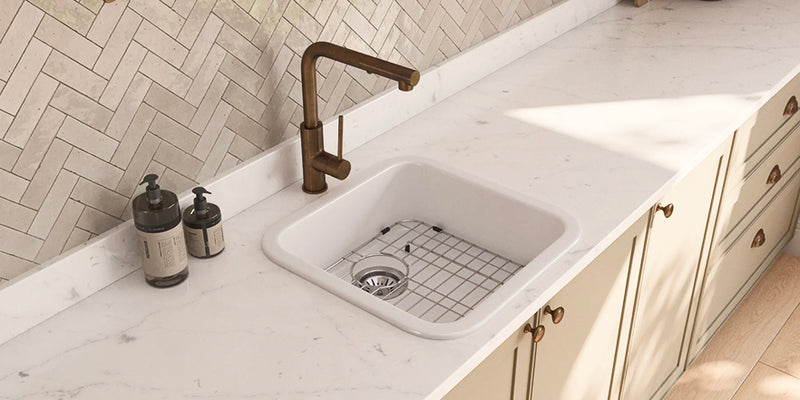
WHY FIRECLAY ADDS HANDMADE CHARM AND LASTING DURABILITY
Glossy and handcrafted, fireclay kitchen sinks offer a traditional aesthetic with modern durability. Its non-porous surface resists scratches, stains, and odours.
Popular in apron-front or butler-style designs, fireclay brings a sense of elegance and weight to traditional or transitional kitchens. It’s also easy to clean and stands up well to daily wear.
WHAT TO CONSIDER BEFORE CHOOSING FIRECLAY
Fireclay is heavier and more fragile to install than other sink types. If it chips or cracks, repairs can be costly and often require a full replacement. Their depth and apron-front style can also be uncomfortable for some users over long periods of use, especially without adequate matting or ergonomic planning.
Because of their handmade nature, slight variations in size or finish are common. Measure carefully before cutting your benchtop.
Copper or Brass
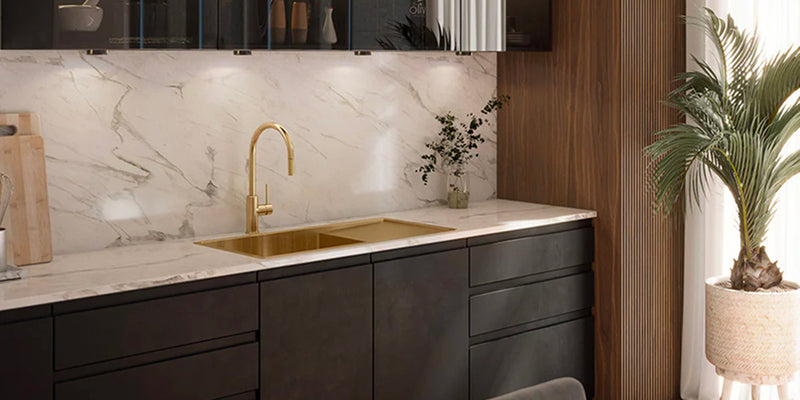
WHY COPPER AND BRASS SINKS MADE A BOLD VISUAL STATEMENT
Copper and brass kitchen sinks offer show-stopping impact with rich, warm tones that naturally patina over time for a one-of-a-kind look. Antimicrobial by nature, these materials can help reduce bacteria on contact and are ideal for statement spaces.
They pair beautifully with natural materials, aged metals, or heritage-inspired tapware, and are a favourite in luxe, rustic, or industrial kitchens.
KEY CONSIDERATIONS
These sinks require care to maintain their finish. Acidic foods, harsh cleaners, or even fingerprints can accelerate tarnishing, which may be desirable or not depending on your taste. Choose between a living finish (that develops patina) or a sealed finish (to lock in the original look).
Copper and brass are softer than stainless steel, so they can dent more easily and may not suit high-impact environments.
Must-Have Kitchen Sink Accessories to Upgrade Functionality
Once you’ve picked the perfect sink, the right add-ons can elevate style and practicality.
Think about how you use your sink every day: do you need to rinse delicate glassware, drain pasta hands-free, or protect the basin from heavy pots? Start by identifying your core tasks (like rinsing, draining, drying) then choose accessories that streamline each one.
For a scratch-free base, look for a grid protector in the right size that sits just above the sink floor. Clip-in colanders make washing and draining veggies effortless, while a portable drainboard gives you extra drying space when you need it and tucks away when you don’t.
For a perfect fit in your sink, Buildmat’s custom-cut grids and colanders slot seamlessly into your bowl, and our fold-away drainboards expand your workspace without the clutter.
Browse Buildmat’s Curated Sink Accessory Range
How to Clean and Maintain Your Kitchen Sink
Proper maintenance keeps your sink looking new, prevents damage, and extends its lifespan. Follow these guidelines tailored to your sink’s material and daily use:
Daily Cleaning
Rinse the basin with warm water after each use to wash away food scraps. Apply a mild dish soap or non‑abrasive cleaner with a soft cloth or sponge, working in gentle circles (always following the grain on stainless steel to avoid micro‑scratches).
Choose a pH‑neutral cleaner to protect the finish of granite composite or fireclay. Finish by drying the surface with a microfiber cloth to prevent water spots and mineral deposits.
Avoid Harsh Chemicals
Abrasive powders, bleach or ammonia‑based cleaners can erode protective coatings, dull finishes and even pit metal over time. Never use steel wool or harsh scouring pads, which leave permanent scratches.
Instead, stick to gentle, non‑abrasive products specifically labelled safe for your sink material. Homemade baking soda paste or purpose‑made stainless steel and composite cleaners work best.
Routine Checks
Once a month, take a look under the sink for leaks, moisture or mould around plumbing fittings. Check the silicone or sealant at the rim for gaps or mildew, and reapply a waterproof caulk if needed to maintain a watertight seal.
For undermount or farmhouse sinks, ensure mounting clips and screws remain tight to prevent shifting. Early detection of small issues (like a loose clamp or a developing chip) can save you from costly repairs later.
Protection accessories
Sink protector grids are a simple but effective way to reduce wear and tear on your sink. Elevating dishes and cookware slightly above the basin surface prevents scratching, scuffing, and direct impact, especially for stainless steel and fireclay sinks. These grids also help improve drainage and keep food scraps from clogging the drain, making everyday cleaning easier.
Buildmat’s grids are custom-fit to ensure full coverage and add an extra layer of protection while preserving your sink’s finish.
Further Reading
Your perfect sink is closer than you think.
Choosing the right kitchen sink is about more than just looks. It’s about making daily life smoother, cleaner, and more enjoyable. With the right size, style, and material, your sink becomes a hardworking feature that lifts your entire kitchen renovation.
Still narrowing your options? Start by browsing Buildmat’s full sink collection to compare styles side by side, or chat with the team for expert advice tailored to your layout and lifestyle.
Ready to renovate with confidence?
Frequently Asked Questions
FAQs
Stainless steel and granite composite sinks are excellent choices due to their durability and ease of maintenance.
Measure the available countertop space and consider clearance requirements. Consult a sink selection guide if needed.
Yes, undermount sinks require precise installation to ensure proper sealing and to prevent leaks.
Abrasive cleaners should be avoided as they may scratch the surface. Use mild detergents and soft cloths instead.
A deep clean every couple of weeks is recommended, or more frequently if the sink is used heavily.
Minor scratches on stainless steel can sometimes be buffed out, but significant damage may require professional repair or replacement.





















































































































































































































